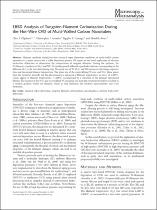 ResearchSpace
ResearchSpace
EBSD analysis of tungsten-filament carburization during the hot-wire CVD of multi-walled carbon nanotubes
JavaScript is disabled for your browser. Some features of this site may not work without it.
- ResearchSpace
- →
- Research Publications/Outputs
- →
- Journal Articles
- →
- View Item
| dc.contributor.author |
Oliphant, CJ

|
|
| dc.contributor.author |
Arendse, CJ

|
|
| dc.contributor.author |
Camagu, ST

|
|
| dc.contributor.author |
Swart, H

|
|
| dc.date.accessioned | 2014-09-30T13:15:14Z | |
| dc.date.available | 2014-09-30T13:15:14Z | |
| dc.date.issued | 2014-02 | |
| dc.identifier.citation | Oliphant, C.J, Arendse, C.J, Camagu, S.T and Swart, H. 2014. EBSD analysis of tungsten-filament carburization during the hot-wire CVD of multi-walled carbon nanotubes. Microscopy and Microanalysis, vol. 20(1), pp 4-13 | en_US |
| dc.identifier.issn | 1431-9276 | |
| dc.identifier.uri | http://journals.cambridge.org/action/displayAbstract?fromPage=online&aid=9159633&fileId=S1431927613014001 | |
| dc.identifier.uri | http://hdl.handle.net/10204/7692 | |
| dc.description | Copyright: 2014 Cambridge University Press (CUP). This is an open access journal. The journal authorizes the publication of the information herewith contained. Published in Microscopy and Microanalysis, vol. 20(1), pp 4-13 | en_US |
| dc.description.abstract | Filament condition during hot-wire chemical vapor deposition conditions of multi-walled carbon nanotubes is a major concern for a stable deposition process. We report on the novel application of electron backscatter diffraction to characterize the carburization of tungsten filaments. During the synthesis, the W-filaments transform to W(sub2)C and WC.W-carbide growth followed a parabolic behavior corresponding to the diffusion of C as the rate-determining step. The grain size of W, W(sub2)C, and WC increases with longer exposure time and increasing filament temperature. The grain size of the recrystallizing W-core and W2C phase grows from the perimeter inwardly and this phenomenon is enhanced at filament temperatures in excess of 1,4008C. Cracks appear at filament temperatures .1,6008C, accompanied by a reduction in the filament operational lifetime. The increase of theW(sub2)C and recrystallizedW-core grain size from the perimeter inwardly is ascribed to a thermal gradient within the filament, which in turn influences the hardness measurements and crack formation. | en_US |
| dc.language.iso | en | en_US |
| dc.publisher | Cambridge University Press (CUP) | en_US |
| dc.relation.ispartofseries | Workflow;12604 | |
| dc.subject | Chemical vapor deposition | en_US |
| dc.subject | Tungsten filament | en_US |
| dc.subject | Carburization | en_US |
| dc.subject | Microhardness | en_US |
| dc.subject | Electron backscatter diffraction | en_US |
| dc.title | EBSD analysis of tungsten-filament carburization during the hot-wire CVD of multi-walled carbon nanotubes | en_US |
| dc.type | Article | en_US |
| dc.identifier.apacitation | Oliphant, C., Arendse, C., Camagu, S., & Swart, H. (2014). EBSD analysis of tungsten-filament carburization during the hot-wire CVD of multi-walled carbon nanotubes. http://hdl.handle.net/10204/7692 | en_ZA |
| dc.identifier.chicagocitation | Oliphant, CJ, CJ Arendse, ST Camagu, and H Swart "EBSD analysis of tungsten-filament carburization during the hot-wire CVD of multi-walled carbon nanotubes." (2014) http://hdl.handle.net/10204/7692 | en_ZA |
| dc.identifier.vancouvercitation | Oliphant C, Arendse C, Camagu S, Swart H. EBSD analysis of tungsten-filament carburization during the hot-wire CVD of multi-walled carbon nanotubes. 2014; http://hdl.handle.net/10204/7692. | en_ZA |
| dc.identifier.ris | TY - Article AU - Oliphant, CJ AU - Arendse, CJ AU - Camagu, ST AU - Swart, H AB - Filament condition during hot-wire chemical vapor deposition conditions of multi-walled carbon nanotubes is a major concern for a stable deposition process. We report on the novel application of electron backscatter diffraction to characterize the carburization of tungsten filaments. During the synthesis, the W-filaments transform to W(sub2)C and WC.W-carbide growth followed a parabolic behavior corresponding to the diffusion of C as the rate-determining step. The grain size of W, W(sub2)C, and WC increases with longer exposure time and increasing filament temperature. The grain size of the recrystallizing W-core and W2C phase grows from the perimeter inwardly and this phenomenon is enhanced at filament temperatures in excess of 1,4008C. Cracks appear at filament temperatures .1,6008C, accompanied by a reduction in the filament operational lifetime. The increase of theW(sub2)C and recrystallizedW-core grain size from the perimeter inwardly is ascribed to a thermal gradient within the filament, which in turn influences the hardness measurements and crack formation. DA - 2014-02 DB - ResearchSpace DP - CSIR KW - Chemical vapor deposition KW - Tungsten filament KW - Carburization KW - Microhardness KW - Electron backscatter diffraction LK - https://researchspace.csir.co.za PY - 2014 SM - 1431-9276 T1 - EBSD analysis of tungsten-filament carburization during the hot-wire CVD of multi-walled carbon nanotubes TI - EBSD analysis of tungsten-filament carburization during the hot-wire CVD of multi-walled carbon nanotubes UR - http://hdl.handle.net/10204/7692 ER - | en_ZA |





